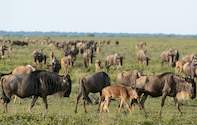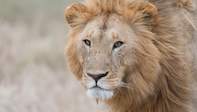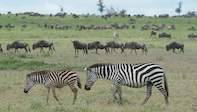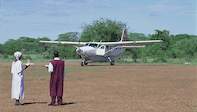
Two World Heritage Sites and two Biosphere Reserves have been established in this region and the unique Serengeti ecosystem has inspired writers, film directors, photographers and scientists. The Serengeti ecosystem is one of the oldest on earth. Features of climate, vegetation and fauna have barely changed in the past million years.
Migration and beyond
The movement of wildebeest across the Serengeti-Mara ecosystem is one of the greatest spectacles in the natural world and for which Serengeti is most famous for. The endless plains fills with 1.5 million wildebeest, 200 000 zebra, 18 000 eland and 500 000 Thompson's gazelle, tracked by the predators and scavengers.
When the migration is not present, the Serengeti still offers the most incredible game-viewing in Africa. Great numbers of buffalo, elephant, giraffe, eland, topi, impala and Grant's gazelle are seen on the plains. The Serengeti is famous for its large lion population. Cheetah, leopard and spotted hyena are also seen. Over 500 bird species have been identified.
Serengeti Activities

Meaning "endless plains" in the Maasai language, the Serengeti offers hot air balloon safaris, walking safaris, picnics, bird watching, game drives, bush lunches/dinners, visits to the Olduvai Gorge.
Explore the plains of the Serengeti on early morning and late afternoon game drives in open 4x4 safari vehicles. Morning game drives begin as the sun is rising and afternoon game drives depart as the heat of the day dissipates. Should guests prefer, the two game drives can be replaced with one longer game drive, with a picnic lunch provided.
There are good lodges and permanent tented camps within the park. There are also different grades of camping safaris - all are comfortable with good facilities and guides. There are several semi-permanent mobile tented camps in the Serengeti. Most of these camps move seasonally, trying to anticipate the migration's movements. The tented camps will spend several months in one place before moving on with the wildlife.
Southern Plains of Serengeti

The Seronera area
Seronera is in the heart of the national park. A scenic area with open plains, occasional kopjes and hills - Seronera offers excellent resident game with high densities of relaxed leopards, cheetah and lion. The migration passes through here in April/May, but as Seronera is within reach of both the Southern Plains and the Western Corridor, it can be a base to see the migration during November to June.Western Corridor
The Serengeti narrows into what's known as the Western Corridor. Two rivers, the Grumeti and the Mbalageti, support riparian forest areas. This area has a good permanent game population, including many zebra and wildebeest, predators and colobus monkeys. The migration passes through this area between May and July - crossing the crocodile-rich waters of the Grumeti River, into the Grumeti Reserve.Northern Serengeti
The northern Serengeti has good permanent populations of wildlife. The beautiful Lobo Kopje is a highlight. The further north you travel, the fewer vehicles you see. The migration is seen here, between August and October, and guests will still witness spectacular crossings of the Mara River.Getting to the Serengeti

There are scheduled and charter flights from Arusha and Lake Manyara to Serengeti National Park. It is possible to drive from Arusha, Lake Manyara, Tarangire or Ngorongoro Crater. It is about a seven hour drive from Arusha.
For amazing wildlife viewing the Serengeti is best visited between November/December and May. Calving takes place around January/February in the south of the park. During the dry season (May) many animals migrate to the Masai Mara where they stay usually from July - October. By the end of July most animals are either in the north of the Serengeti or in the Masai Mara. The animals return, leaving the Mara usually in October and arrive back in the Serengeti in great numbers by November.
Serengeti Safari Packages
- Unspoiled Serengeti Safari
- Classic Serengeti Under Canvas Safari
- Deluxe Tanzanian Tented Safari
- Romantic Secluded Serengeti Safari
- Kids Serengeti Explorer Safari
Please note that we can tailor-make a Serengeti National Park safari tour of any duration to suit your requirements.

 See recommended Safari Lodges in Serengeti National Park. From May to July you can witness the annual great migration of millions of Zebra a...
See recommended Safari Lodges in Serengeti National Park. From May to July you can witness the annual great migration of millions of Zebra a... The Northern Serengeti region is sandwiched between Kenya and Tanzania, and is a great base destination for an African wildlife safari. The...
The Northern Serengeti region is sandwiched between Kenya and Tanzania, and is a great base destination for an African wildlife safari. The...